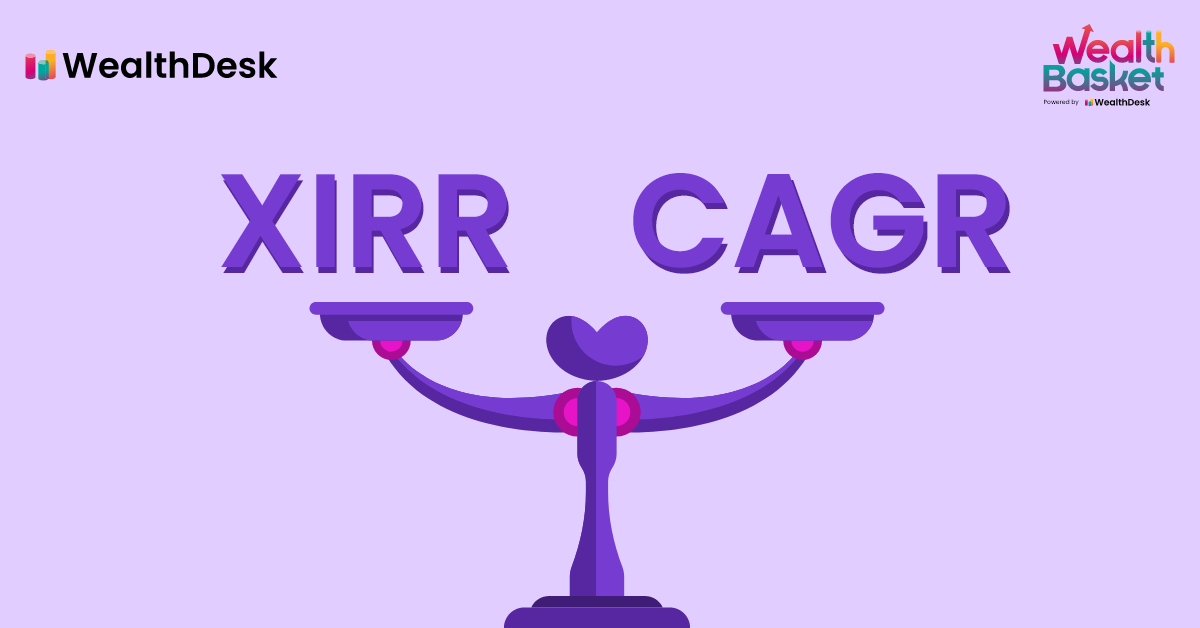Many new investors in various financial products are greeted by multiple terms like XIRR or CAGR. These terms even stump investors who have been investing for some time but suddenly check their statement one fine day. If you are one such person, you will obviously wonder what CAGR is or XIRR.
For the more curious, how to calculate CAGR or XIRR could be on their minds.
Let us try to decode these terms and understand their importance.
What is CAGR?
CAGR stands for Compounded Annual Growth Rate. It is one of the popular ways to calculate long term growth. In the context of investments, CAGR is used to calculate long term returns when you are purely looking for the growth between two distinct points over a certain period. It tells you the annualized growth of your investment.
For instance, if you invested Rs 10,000 in October 2018, which has grown to Rs 20,000 in October 2021, you will know it took 3 years for your money to double. In other words, you will know you have earned 100% returns in 3 years.
However, you need to apply the CAGR calculation to understand the annual return. In this case, it will be 25.99%.
How to Calculate CAGR?
To calculate the annualized growth over a period, you will have to use the formula:
CAGR = [(End Value/Starting Value)^1/t] – 1, where t = time in years
In the above example, our starting value is Rs 10,000, our end value is Rs 20,000 and time in years is 3. Accordingly, our CAGR will be [(20,000/10,000)^1/3]-1, which turns out to be 25.99%.
Advantages of using CAGR:
Simplicity
CAGR provides a simple, understandable measure of annual growth over a specific period of time.
Time-Value of Money
It takes into account the time value of money by compounding the returns, which is a more accurate measure of investment performance.
Smoothing Out Volatility
It smooths out the effects of volatility and fluctuations in the market, providing an average growth rate.
Comparability
CAGR allows for easy comparisons between different investments or between an investment’s performance and a benchmark.
Disadvantages of using CAGR:
Not for Short-Term
CAGR is not a good measure for short-term investments (usually lesser than a year) as it’s designed to measure steady growth over a long period.
Ignores Volatility
CAGR smooths out the effects of market volatility. This can be a disadvantage if you’re trying to understand the risks involved in an investment, as it overlooks yearly fluctuations.
Assumes Reinvestment
CAGR assumes that all gains are reinvested at the end of each year, which might not always be the case.
Can Mislead
Since CAGR provides an average, it can be misleading. For instance, if an investment saw huge gains in the early years followed by losses, the CAGR could still appear positive.
Ignores Cash Flows
CAGR doesn’t take into account any additional investments or withdrawals (cash flows) made during the period under consideration.
What is XIRR?
XIRR stands for Extended Internal Rate of Return. Simply put, it is helpful to calculate returns on investment when there are multiple inflows or outflows in a portfolio. As most investors invest in mutual funds through SIPs, XIRR can be a helpful formula to calculate the average annualized return on the entire portfolio.
How is XIRR Calculated?
Let us understand it through an extension of the previous example. Suppose you started investing Rs 10,000 every year for three years and are looking at the final amount of Rs 60,000 at the end of 5 years.
In that case, it will be challenging to arrive at the annualized return for each investment and then a combined value. So instead, you use the XIRR function or formula in a spreadsheet to do this calculation.
In other words, your first instalment had 5 years to grow, the second instalment had 4 years, and the third instalment only had 3 years to grow. So if you look at the final amount of Rs 60,000, you could feel that your investment has doubled, or the absolute return on your investment is 100%, which is also true.
However, that doesn’t consider the time variations.
Now, suppose you use the XIRR function in spreadsheets or use an XIRR calculator available online. In that case, you will realize that the XIRR or the annualized average return on your investments is 18.61%.
Advantages of XIRR:
Accounting for Timing
XIRR takes into consideration the timing of cash flows, which is especially useful for investments where cash inflows and outflows occur at irregular intervals.
Accurate Performance Assessment
XIRR provides a more accurate measure of an investment’s performance as it adjusts for the fact that returns can be reinvested.
Compares Different Investments
It can be used to compare the returns from different investments and to judge the effectiveness of investment decisions.
Considers All Cash Flows
It uses all cash flows from the investment including interim cash flows, not just the initial and final ones.
Disadvantages of XIRR:
Assumes Constant Reinvestment Rate
XIRR assumes that all cash inflows are reinvested at the same rate as the XIRR. In reality, this may not be the case as reinvestment rates could vary.
Complex Calculation
It is more complex to calculate than simple return or annualized return methods, especially when done manually.
Possible Multiple Solutions
For some cash flow sequences, the XIRR equation may have multiple solutions, potentially causing confusion or misinterpretation.
Overstates Earnings
If used with speculative investments that don’t really have interim cash flows, it can overstate earnings by assuming compounding over periods when no investment is actually made.
Difference between XIRR and CAGR
| XIRR (Extended Internal Rate of Return) | CAGR (Compound Annual Growth Rate) | |
| Calculation Method | XIRR calculates the rate of return when there are multiple cash flows occurring at different times. It incorporates the timing and amount of cash flows, providing a more accurate reflection of the actual return. | CAGR simplifies the return to a single annual rate that represents the compound return over a period. It’s an average growth rate over multiple periods, and it assumes that profits are reinvested at the end of each year. |
| Use Case | XIRR is better suited to investments where cash flows occur at irregular intervals or where there are multiple cash flows (such as in mutual funds). | CAGR is best for investments where the return is realized at the end of the investment period (such as stocks, bonds, or fixed deposits). |
| Complexity | XIRR calculation is more complex as it involves iterative calculation, and often a financial calculator or spreadsheet software is used. | CAGR formula is relatively simple and straightforward. |
| Accuracy | XIRR is more accurate for real-world applications where investments and returns are made at different times. | CAGR assumes that the investment compounds over time, which may not be true in many real-world cases, making it less accurate. |
| Cash Flow Assumption | XIRR takes into account the size and timing of each individual cash flow, both inflow and outflow. | CAGR does not account for cash inflow or outflow during the investment period, only considering the starting and ending values. |
Final Thoughts
It is important for investors to know certain basics like the difference between XIRR and CAGR, or the importance of such metrics in their investment journey. You can also invest in modern investment portfolios called WealthBaskets which are curated by top SEBI registered Advisors.
Staying abreast of the developments in your portfolio and understanding all the nuances goes a long way in investment success.
Discover stocks that suit certain filter criteria and dive into details to check their WealthBaskets.
FAQs
While CAGR is used to calculate returns only between
two points of time, XIRR is used to calculate
returns even in situations where there are more than
one credit and debit in the entire chain of
transactions, or timeline of investments.
Accordingly,
while CAGR can help you understand the annualized
return on a savings bank deposit over a few years,
XIRR will be needed to calculate the returns from a
mutual fund Systematic Investment Plan, or Recurring
Deposit.
A CAGR return can be termed good for any portfolio
only based on some other underlying facts, like the
risk appetite of an investor and the financial
product used for investments. For instance, with
inflation around 6% and interest rates also around
the same level, a CAGR of 6% from fixed deposits can
be considered a good CAGR.
This is for a
conservative investor who does not want to take
major risks. A good CAGR for an aggressive investor
investing in high-risk products like stocks, on the
other hand, will be upwards of 10% or 15%.
Many investors are keen to understand
what is CAGR in stocks. The CAGR
calculation method can be used to calculate the
annualized return on your stock investments over a
period of time.
However, it is important
to note that CAGR calculation is applicable when you
are calculating returns on a single product or stock
in a time period. If there have been multiple
investments or withdrawals in a portfolio, it is
better to use the XIRR calculation.
The Internal Rate of Return (IRR) calculated using
the XIRR function in Excel and CAGR are very
different calculation formulas suitable for
different types of growth and investment patterns.
If you have invested a lump-sum in a single product
or stock and want to calculate the growth rate
after, say, 2 years or 5 years, or 7.5 years, CAGR
will be better for you.
However, if you
have bought some shares from time to time over many
years or months, or have been investing in mutual
funds through a systematic investment plan, then
using the XIRR is a better choice.


















